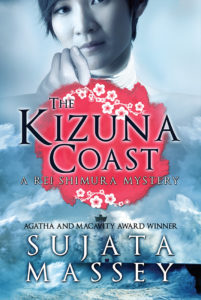Sue Trowbridge is the founder of Interbridge.com. She designs book interiors and websites for authors. Her clients include such well-known authors as William Kent Krueger, Cara Black, Libby Fischer Hellmann, Rhys Bowen, Sujata Massey, Ellen Hart, Naomi Hirahara, Susan McBride, Terence Faherty, John Gilstrap and many more.
Pressbooks: You’ve produced more than a dozen books using Pressbooks. Tell us about some of them.
Sue: One of my favorite books to work on was a restaurant guide to Paris written by Terrance Gelenter, an American who fulfilled his dream of moving to France and now serves as a travel consultant and tour guide. It’s a quirky, personal guide called “Terrance’s 50 Favorite Paris Bistros & Restos”
Dining out in Paris can be surprisingly challenging for American visitors, so having a useful and fun book like this is of real benefit.
Another book I’m really proud of is Sujata Massey’s “The Kizuna Coast.” Sujata is someone I’ve known for many years and in the 1990s, she won many awards and a huge fan base for her Rei Shimura mystery series, about a young American-Japanese antiques buyer. During a period of consolidation in the publishing industry in the early 2000s, her series was dropped, and she went on to write a mainstream novel set in India, “The Sleeping Dictionary, “which was published in 2013 by Simon & Schuster. The 2011 earthquake and tsunami in northeastern Japan spurred Sujata into revisiting the Rei series and I persuaded her to self-publish the book instead of trying to find a publisher (which would have been difficult when you’re talking about book #11 in a long-dormant series). I assured her that with Pressbooks, we could produce a book that would look just as good (or better!) than anything the major publishing houses would produce. She had Deranged Doctor Design do the fabulous cover, and I did a custom Pressbooks layout. The book is available not only as an ebook and trade paperback, but Sujata also published it as a limited-edition hardcover through Ingram Spark.
Pressbooks: As a book designer, what do you want clients to know about book interiors for print and ebooks?
Sue: I tried various tools, including Microsoft Word and Adobe InDesign, before finding Pressbooks. As a Web designer, I was already familiar with the WordPress platform – I know many writers use it as well, both for blogs and as a content management system for websites. Because Pressbooks is built on a WordPress-style interface, the learning curve is much less steep, and you can produce a great looking product. Of course, lots of people would rather focus on their writing instead of book design, so that’s where my business comes in!
Pressbooks: You provide a variety of services to authors. What aspects of self-publishing do you recommend that indie authors handle themselves and why?
Sue: The one aspect of self-publishing that every author must deal with him- or herself is publicity. Even if your books are published by a major New York house, unless you’re Jonathan Franzen or Sue Grafton, chances are no one’s going to be buying ads for your book or even helping you with your social media or website. My advice is to find the thing you like doing, whether it’s Pinterest or Facebook or Twitter or blogging, and stick with it. Don’t force yourself to try to do everything. I find that most people tend to be either “Facebook people” or “Twitter people” – few like both equally. (I’m a Twitter person myself; my handle is @trow125.) Talk to other, more experienced writers to find out what worked for them and what they tried and considered to be a waste of money. Check out blogs like J.A. Konrath’s “A Newbie’s Guide to Publishing,” Kristine Rusch’s “Business Rusch,” or “The Passive Voice” – reading through the archives of those sites is the equivalent of getting a master’s degree in indie publishing.
Pressbooks: You say you’re still a fan of the printed book. (So are we!) What do you see as the central value of this format, and how does Pressbooks make creating print books easy?
Sue: I think reading a printed book just provides a better experience than reading an ebook; the one exception is for traveling, when the Kindle is so much more convenient. I thought maybe my preference had to do with coming of age in the era before ebooks, but according to recent studies, even millennials prefer print. Even though my Kindle is an old-school one that only serves as an e-reader, without the distractions of game apps and Web browsers, I find I’m better able to focus when I’m reading a paper book.
The PDF output you can generate with Pressbooks is attractive (I love checking out the new templates!) and the interiors look great whether you’re publishing through CreateSpace, Ingram Spark, or even using an offset printer. Most of my clients’ books are POD (print on demand), but Terrance Gelenter’s restaurant guide was printed in bulk by a printer in Paris; he sells copies himself every Sunday at the Café de Flore.
Pressbooks: For someone who is ready to go about self-publishing and isn’t sure where to start, what five things do you think they need to know?
Sue: First of all, even though you can press a button and publish your book immediately on Amazon doesn’t mean you should. Most people are lousy editors of their own work. The good news is that there are lots of great freelancers out there. My friend Lee Goldberg, who is a hybrid author, said a big step forward in his indie publishing career came when he realized that he could hire the same freelance editors used by the big New York houses. If you can’t afford to hire a professional, at least find another author and perhaps edit each other’s books, both for content and continuity (if you refer to the main character’s blue eyes in chapter two, people will notice if they’re suddenly brown in chapter 14!).
Second, once you think your book is 100 percent done, find somebody else to proofread it for you. If you read reviews of indie-published books on Amazon, notice how many readers complain about typos and formatting errors. It’s a big turnoff that can distract people from your plot and characters!
Third, invest in a professional-looking cover. You’re competing with thousands of other books in a crowded marketplace and I believe this is one of the places where many indie authors can lose out. Deranged Doctor Design, which did Sujata’s cover, does amazing work and their prices start at just $95. (I have no affiliation with them; I just like their covers.) I know other authors who have gotten good results from using online marketplaces like 99 Designs.
Fourth, don’t just sell through Amazon – yes, they’re the Goliath in this biz and most people find their interface much easier to use than other platforms, but many of my clients are making good money from Kobo, Nook, the Apple Store, etc. This is particularly true if you want to try to do an event at your local independent bookseller or just have them stock your book. Most booksellers see Amazon as the enemy and won’t order CreateSpace-only titles, but they’ll happily deal with books you published through IngramSpark.
Finally, find support through affinity groups like Mystery Writers of America, Sisters in Crime, Romance Writers of America, local writers’ groups, etc., or by attending a conference like Left Coast Crime, Malice Domestic, the Romance Writers of America Convention, etc. Writers are a friendly, helpful bunch and most of them will be happy to share their expertise; conventions usually have lots of panels these days geared at the indie writer. (I just moderated a panel on social media for authors at the annual Left Coast Crime mystery convention). One of my clients, who published her first novel in the early 1990s, said she came home from Left Coast Crime feeling energized about both writing and marketing.
Pressbooks: What type of author or book is the best for self-publishing, in your opinion?
Sue: Genre fiction – romance, mystery, Westerns – usually does well. Many of my clients are authors (like Sujata or Libby Fischer Hellmann) who already have a built-in fan base from their traditionally published efforts, but there are plenty of indie-only success stories out there. The most important thing you can do is to keep writing and working to improve your craft.
To learn more about Sue Trowbridge or to commission Sue’s services, go to interbridge.com.




